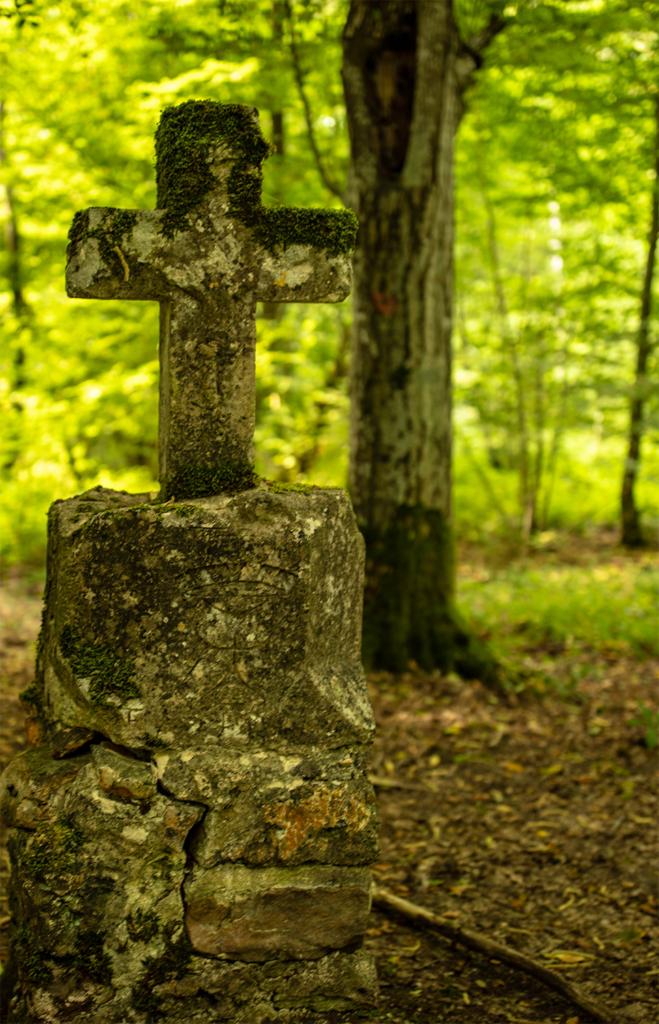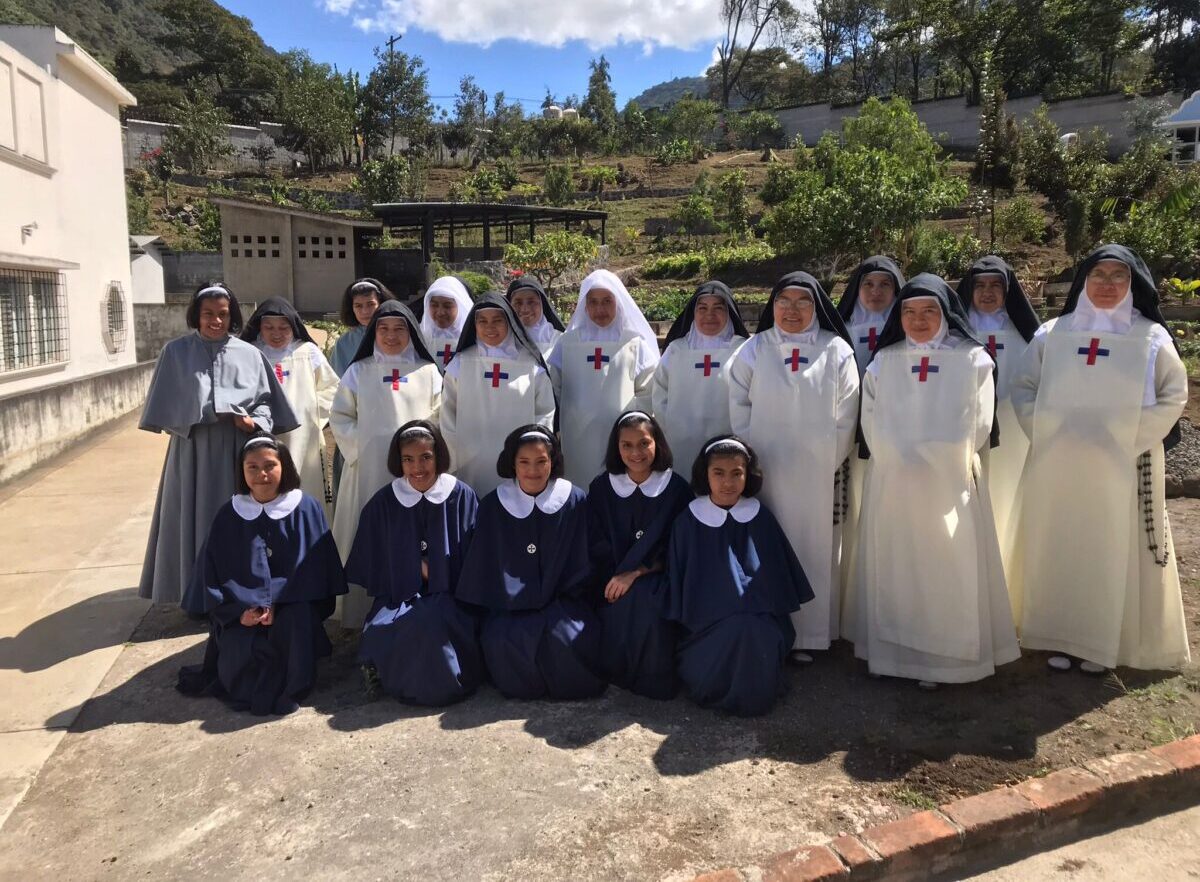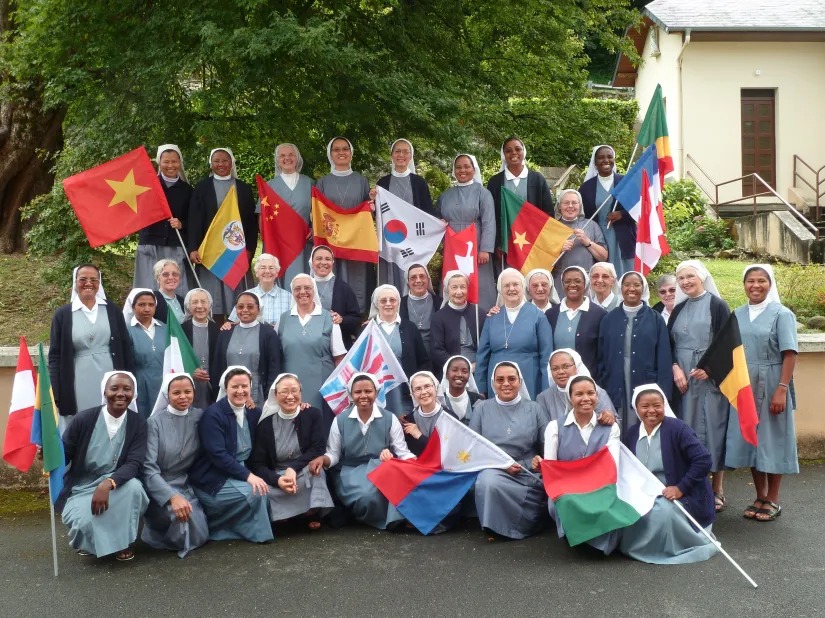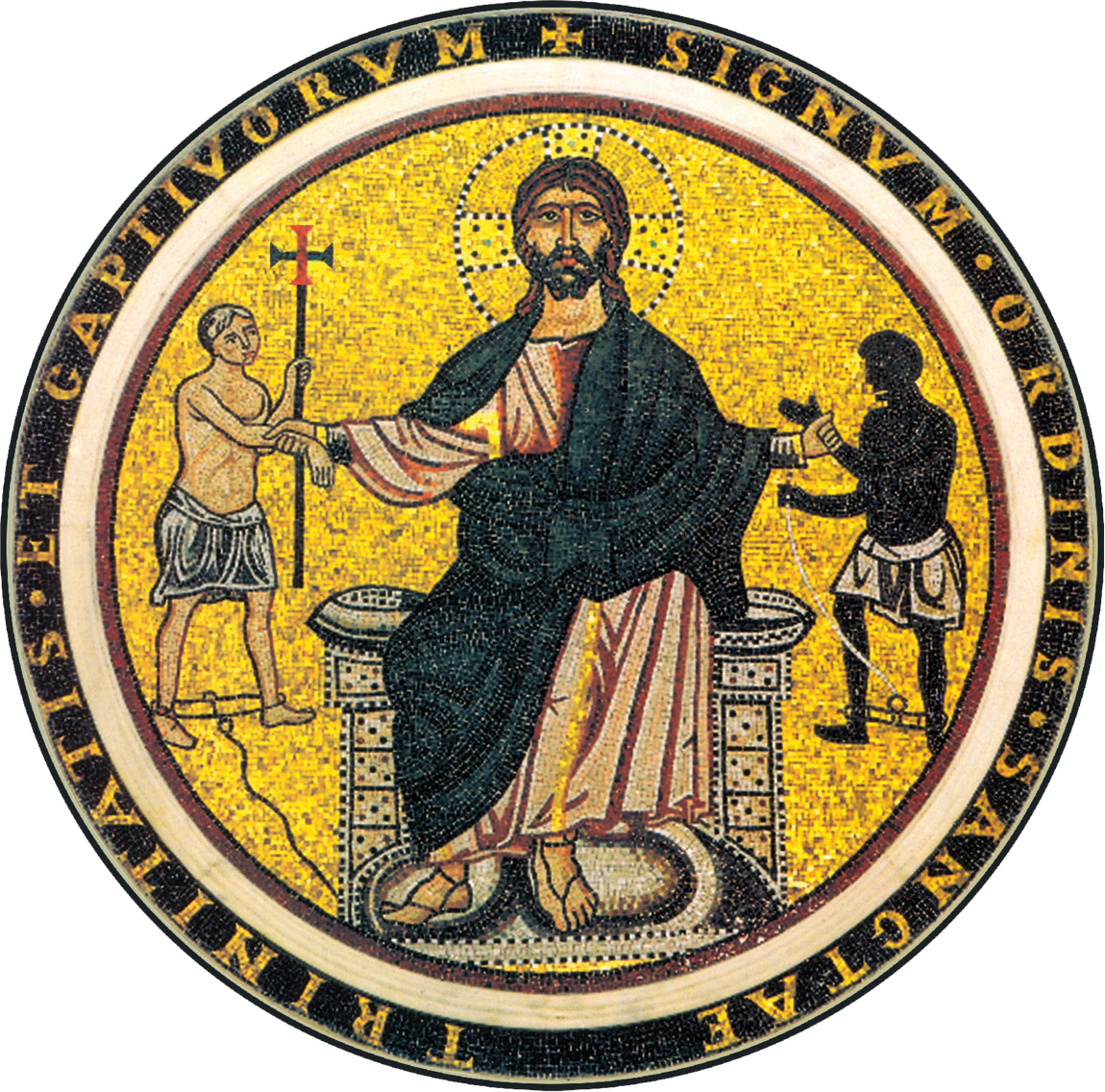A United Trinitarian Family
The Trinitarian Family consists of brothers, sisters and lay people who bear the Trinity name as an appellation and recognize John of Matha as their father. All share in the same redeeming Trinitarian charism and continue in history his mission of: glory of the Trinity and redemption of the captives of our time.
We are members of the Trinitarian Family: the Trinitarian religious, the Trinitarian contemplative nuns, the Trinitarian religious of Valence (France), the Trinitarian sisters of Rome, the Trinitarian religious of Valencia (Spain), the Trinitarian sisters of Madrid (Uqrquijo), the Trinitarian religious of Mallorca, the Trinitarian mothers of Seville (Beaterio), the Oblates of the Holy Trinity (Rome) and the Trinitarian laity.

The Order
The Order was founded by St. John de Matha with the collaboration, according to tradition, of St. Felix de Valois. It is an Order with its own Rule, approved by Pope Innocent III. The papal bull of approval bears the date of December 17, 1198. The Order was reformed by St. John Baptist of the Conception in 1599, with the approval of Clement VIII.
Its religious, priests and brothers, consecrated in a special way to the Trinity, are dedicated to the service of redemption and mercy on behalf of those persecuted because of their faith, the oppressed suffering from present-day slavery and the poor.
The Order has 54 communities in Europe; 22 in the U.S. and Canada; 21 in Latin America; 10 in Madagascar; 2 in India; and 2 in Continental Africa.
Trinitarian Sisters and Cloistered Nuns
Cloistered Trinitarian Nuns
The first Trinitarian Cloistered nuns were the two daughters of King Peter II of Aragon: Donna Constance, who died in the concept of sanctity, and Donna Sancha. They had inherited their father’s esteem for St. John de Matha and wanted to help him, not only with their prayers and donations, but also by consecrating themselves to the Most Holy Trinity. Their first monastery was Our Lady of the Angels in the diocese of Lerida. After Spain, where they founded numerous Convents, they spread to Portugal, France, Italy, Peru, Chile and currently to Madagascar.
Cloistered Trinitarian Nuns lead an entirely contemplative life; consecrated to the Most Holy Trinity and with their own redemptive mission in the church, they live in solitude and silence, in assiduous prayer and generous penance.
They have 16 monasteries in Spain, 1 in Lima, 1 in Chile, 1 in Guayaquil, 1 in Guatemala and 1 in Madagascar.
Trinitarian Sisters of Valence
The congregation was founded by Jeanne Adrian and a group of young women affiliated with the Confraternity of Trinitarians of Lyon. Its purpose was the glorification of the Trinity and to dedicate themselves to the Redemption. They attended to poor young people and the sick. Returning from Africa, the redeemed slaves were received in their hospital in Valence.
The sisters live a life of prayer and a community life, in the image of the Three Divine Persons. Their current apostolate is Christian education, care of the poor and sick, missions and pastoral care.
They currently have 58 communities, present in Europe, Africa, Madagascar, South Korea, Canada, Latin America and India.
Trinitarian Sisters of Seville
The sisters of the Beaterio of the Most Holy Trinity of Seville were founded on February 2, 1719 by Mother Isabel Rita Moreno of the Most Holy Trinity under the auspices of Trinitarian Father Jose Chacon. The goal they set out for themselves was a special glorification of the Trinity and the welcoming of poor, orphaned and abandoned children.
The congregation is of diocesan right and has been affiliated with the Order since the latter’s restoration in Spain.
Currently, they have two homes, where they devote themselves to teaching and caring for orphan girls.
Trinitarian Sisters of Rome
This congregation was founded by the Servant of God Mother Maria Teresa Cucchiari of the Most Holy Trinity on September 8, 1762. Mother Mary Happy of the Holy Spirit is venerated as a confounder. The foundress and the first sisters were part of the Third Trinitarian Order of St. Carlino in Rome.
They adopted the Trinitarian Rule, having as their aims: the glorification of the Most Holy Trinity, the propagation of her worship and, animated by redemptive charity, the education of childhood and female youth, especially the poorest and neediest. They also currently devote themselves to missions, parish apostolate and welfare apostolate.
They have 35 communities and are present in Italy, U.S.A., Madagascar and the Philippines.

Trinitarian Cloistered Nuns – Guatemala
Trinitarian Sisters of Mallorca
This congregation was founded by Father Miguel Ferrer, a Trinitarian, on August 7, 1809. He himself gave them a rule based on that of the Trinitarians. The first Sisters were part of the Confraternity of the Most Holy Trinity of Felantix (Mallorca).
Their charism is that of a special consecration to the Trinity, the source and origin of all liberating love, praise prayer and work as a means of livelihood and assistance to cooperate in works of mercy. With these characteristics of their own, they devote themselves to teaching, caring for the sick, and help out in parishes, in poorer areas.
They have 21 communities, and are present in Spain, Peru and Bolivia.
Trinitarian Sisters of Madrid
This Institute was founded in Madrid on February 2, 1885 by Venerable Francisco Asis Mendez Casariego and had as its co-founder and first collaborator the Servant of God Mariana Allsopp of the Most Holy Trinity. The Institute joined the Order of the Most Holy Trinity on April 20, 1904 and adopted its redemptive merciful spirit.
Its specific purpose is to seek out, welcome, train and evangelize young people exposed to multiple dangers and difficulties in life. It accomplishes this purpose by always keeping the door open to those in need of a home and help.
True to this orientation, they undertake many initiatives: family homes, boarding houses, prisons, shelters, stations, vocational schools and rehabilitation centers.
The Institute has 30 communities and is present in Spain, Argentina, Mexico, Uruguay and Rome.
Trinitarian of Valencia
This congregation was founded by Rosa Cunat, Tomasa Balbastro, Salvadora Cunat, Ana Maria Gimeno, and Rosa Campos, who, animated by priest Don Juan de la Concepcion Calvos Tomas, committed themselves to living in community and devoting themselves to teaching and caring for abandoned children.
They adopted the Rule of the Trinitarian Sisters of Rome. They joined the Trinitarian Order in 1882, and on November 4, 1885, they received approval from the Church.
The spirituality of the Institute emanates from the Rule of St. John de Matha as the guiding principle of its entire mission.
Worship of the Most Holy Trinity and the liberation of men from the many forms, which slavery takes today, constitute its charism. They take on the mission of evangelizing the poor, devoting themselves to the education of poor boys and girls, not excluding, in addition, whatever may benefit the poor in general.
They number 38 communities and are present in Spain, Argentina, Puerto Rico, Bolivia, Austria and Madagascar.

Trinitarian Sisters of Valence (France)
Secular Institute “Oblates of the Most Holy Trinity”
This Institute was born on June 9, 1960 in St. Thomas in Formis, where Fr. Luigi Cianfriglia brought together five young men who wished to live out their consecration in the world. The Oblates of the Most Holy Trinity live and work in the style proper to Secular Institutes. They testify to consecrated secularity in the Trinitarian Family and recall its ecclesial importance.
They profess evangelical perfection in the midst of the world, bearing witness to the love of the Trinity, and strive for the sanctification of priests and consecrated souls, and for Christian families to be renewed in the image of the Trinity.
In the redemptive and missionary apostolate they collaborate with the Trinitarian Order.
The Institute has members in Italy and currently in Madagascar. It has one house as its headquarters in Rome, but neither canon law nor its own Statutes require other houses. The Vicariate of Rome approved its statutes on April 20, 1994.
The Hermitesses of the Most Holy Trinity
They were born in the Hermitage of the Virgin of Faith, in Guayaquil, Ecuador, on May 20, 1988, the Solemnity of the Most Holy Trinity. They have their own legislation with diocesan approval. The foundress is Mother Maria Amalia of the Most Holy Trinity.
They consecrated themselves to the Trinity, inspired by St. Felix de Valois and St. John de Matha, during their first moments in the Cerfroid Desert.
They lead integrally contemplative lives; devote themselves to the ecumenical welcome of those with faith problems, and live their witness in works of mercy.
They currently have a hermitage in Guayaquil (Ecuador).
Trinitarian laity
Since the beginning of the Trinitarian Order, while the Holy Founder John de Matha is still living, there are faithful of both sexes who, participating in the spirit of the Order, live its spirituality and in communion with it, cooperate in its mission by participating, in various ways and to different degrees, in its charism.
The 1198 Rule indicates the presence of seculars to whom the Minister of the House must give an instruction every Sunday.
In the Bull of February 3, 1198, Pope Innocent III granted permission to receive donates or confreres. In the 1203 contract between the Bishop of Arles and St. John de Matha, reference is made to affiliates of the convent. Special mention should be made of the letter that Bishop Conzalvo, of the city of Segovia, dated Feb. 3, 1208, addressed to his people and clergy, urging them to enroll in the Trinitarian Brotherhood, which he calls “glorious.”
Pope Innocent III, again, in his Bull of June 18, 1209, confirmed the houses founded and the Trinitarian Confraternities. The same is repeated by Pope Honorius III in his Bull of April 25, 1219, in which he gives the faculty to receive new brethren. Innocent IV, on February 20, 1248, confirmed the concessions already granted and urged the faithful to be generous to the Trinitarians and to enroll in such a holy Brotherhood and Fraternity. To those who did, he grants indulgences and other privileges, and takes them under his protection.
There are many other documents from Pontiffs, Bishops, kings that speak of Trinitarian Confraternities, of the Redemption, later of Our Lady of Remedy of other confraternities aggregated to the Order with many people engaged in the work of redemption and in the service of charity on behalf of the slaves, the oppressed and the poor.
We have mentioned only a few significant ones to indicate that the Trinitarian Associations are as old as the Order itself, for from the very beginning there appear affiliated persons who are committed to the glorification of the Trinity and to lending aid on behalf of the enslaved, the oppressed and the poor.
We cannot expect to find a perfect and clear distinction and organization of Associations from the beginning. What is certain, however, is that, in the beginning, the various Fraternities and Brotherhoods, which are mentioned in the documents, were part of the great Trinitarian Fraternity.
Historically, the name Third Order originated with the Order of the Humiliati, recognized by Innocent III. It was composed of people living in the century under a Rule of Life.
Among Trinitarians we know of the drafting of statutes attributed to William the Scotsman, the third Minister General of the Order (1217-1222), and certainly very old; from them we get an idea of the primitive organization of the Trinitarian Brotherhood.
But the first known statutes of the Third Order were published in 1584 and bear the approval of the Order’s Fr. General, Bernardo Dominini. They collect norms of life lived and received from tradition, but the existence of tertiaries, though not called by this name, certainly goes back to the origins of the Order.
In the 1657 Constitutions of the Trinitarians Shoehorned, mention is made of the three vows in the tertiary profession formula; later, profession is reduced to the promise to fulfill the commandments of God’s law and the Rule of Life of the Third Order. Among the Discalced Trinitarians, the first known Rule of Life of the Tertiaries was approved by Pope Leo XII, June 6, 1828; it mentions the issuance of the three vows.
This Rule, with some revisions, approved and confirmed in 1925, again revised and further approved by the Holy See on December 28, 1940, has continued to be in force until our time.
Now, finally, with the approval of the “Life Project of the Trinitarian Laity,” we have precise and valid norms to which all Trinitarian associations must refer.
We can conclude these very brief notes with the words dictated by the Minister General and Superiors General of Trinitarian Institutes in 1987:
“We are well aware that without the laity the Trinitarian Family is not possible. We note that they, from the origins and in the tradition of the Order and some Institutes, have always been an important part; moreover, the orientations of the Church itself are stimulated on this path.”
Glory to you, O trinity, to slaves freedom




